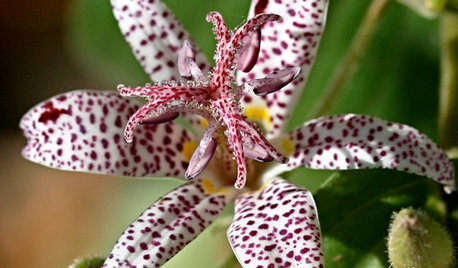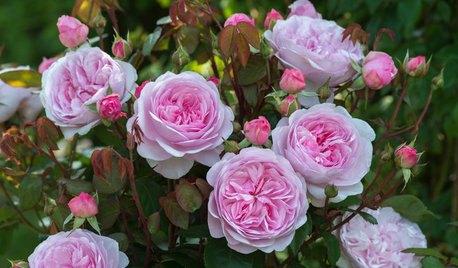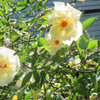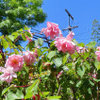Suckering roses plus a non-rosy summer
Melissa Northern Italy zone 8
9 months ago
last modified: 9 months ago
Featured Answer
Sort by:Oldest
Comments (14)
bart bart
9 months agoMelissa Northern Italy zone 8
9 months agoRelated Discussions
What (non-rose) plants are you obsessing over these days?
Comments (72)Cath, Magnolia grandiflora is one of the more tolerant magnolias, and is certainly a magnificent tree, but I'm not interested in it. I long for the deciduous, mostly Asian magnolias: M. stellata, M. denudata, the Soulangeanas, the x loubneri group, the yellow-flowered hybrids of M. acuminata. Actually, I plan on getting a Loebneri magnolia: I think I actually have a place, one spot in our thirty-three acres, where it will grow. Magnolias are fairly common ornamental trees down in the Po Plain below our hills, and in our local town, which is located in a valley and has good alluvial soils. It's five miles away and about 225 meters lower than we are, and they can grow plants that we can't. Conditions vary. It's not that I haven't tried magnolias, but much of the soil in the big garden bears a close resemblance to adobe brick when it's dry, and they just can't handle it. The shade garden either has dry unfriendly soil, or it floods, and I don't think magnolias like to be flooded either (roses on the other hand can handle tremendous amounts of winter water). Also much of the shade garden is shady, of course. But I do have one spot I think will work, and I'm looking forward to getting the right magnolia, and then seeing it in splendor in a few years. They are magnificent, glorious trees. Otherwise I may get a pear for one spot where I want a flowering tree. That may not sound obvious, but pears have a heavy noble structure and a massive whiteness to their bloom that makes them, in my eyes, the hill country aesthetic equivalent of flowering magnolias. harmonyp (Beth?) I think you're right about dahlias. I got rid of my numerous family of them a few years ago after a very long drought because I didn't want to water them; and I got tired of lifting the tubers and keeping them in my mud room through the winter, then replanting them, and staking them. Right now the garden has just three or four survivors that have made it through two unusually cold and wet winters without rotting. I have a handsome pink one growing in the cottage bed next to the house where it flourishes in clay and with little supplementary water. Dahlias come in a great variety of forms and colors, many of them very beautiful: rich burgundies, violets, soft oranges, waterlily pinks. They're undemanding about water and soil. They don't get any pests or diseases to speak of. They make excellent cut flowers. One of the things I liked about dahlias when I was growing them in quantity is how they're movable foliage, excellent for filling in gaps when the shrubs are young; and they have big, bold, flourishing dark leaves with never a trace of mildew. They bloom when much of the garden is quiescent too. Now I'm wondering why on earth I don't have more dahlias. I don't quite trust them to be tough enough to thrive out in the big garden, where life is a battle: they're more suitable to the vegetable patch, and I have very little of that kind of space. Perhaps one year I'll be able to conjure up some room for dahlias. They are wonderful flowers. Melissa...See Moreafternoon sun in summer, no sun in winter? (roses?)
Comments (17)>I'd prefer Felicia to Cornelia since Felicia, I've heard, has stronger scent? or is that not true? I have a couple Felicias that are babies now. (like I said in my previous... I'm not sure if they're doing well or not. They may just be young?) Hi Aimee, Rogue Valley lists them both with three "f's" out of a possible four for degree of fragrance. Francesca is for sure a beautiful rose, so good luck with it! If you ever do consider Cornelia too, well, I've read a few comments that its fragrance wafts on the breeze. >Both Kathleen and Mutabilis (which I guess are similar to Bermuda's Kathleen) are listed as shade tolerant... Neither one makes it to the ARE shade tolerant list, though they do sell both. (The person running that nursery is extraordinarily knowledgeable so I'd take his advice over the opinions of others.) >I'm open to Darlow's Enigma, too. I want something that does WELL there... otherwise I might want to try a shrub or something more tolerant? I've seen so many gorgeous pictures of this very fragrant rose that at one time I wanted it too. But it was a turnoff to discover that it is supposed to be unusually thorny. >I really like camellias too. Mary, that was one of my other ideas. So if the roses won't do well, I'd rather go with something that will do better. Your roses are probably going to do fine, with the right selections, I'd guess. On the other hand, with more thought as to the whole picture, you might want a little greater diversity in the front yard and some things with a bit of a heavier shinier leaf look to them. Two books to help you form your own landscaping ideas: House and Garden Book of Country Gardens," by Charles Quest-Ritson, and Landscape with Roses" by Jeff Cox. Consider Japanese maples if you end up looking for more trees. I never tire of looking at ours (three kinds here). >I have a small camellia roughly in that spot now, it's getting a little bit of burning on the leaves, but overall seems happy, so I'm guessing as it gains maturity, it will be able to tolerate sun better. I don't think you ought to generalize the experience for a single camellia (japonica?) to all the many others you might consider for the same spot. Some varieties aren't too picky about how much sun and sun protection they have, and some are very picky. The variety in that spot is just probably one of the pickier ones and is wishing it were in a slightly shadier spot or were getting better watering. >Mary, how do you mean "for the front walk"? sorry, I can't figure out which part you mean exactly., do you mean along the sidewalk coming from the front door, on both sides...? (before it does a right angle?) Edging each side with shishigashiras would work well for the entire distance, I'd guess. >I'm just having trouble with the part that's right up next to the front of the porch (the foundation) There are an unending number of potential choices and combinations, all of which would make a nice inviting entrance for your house. It all depends on what you personally like best. If it were my house, I'd opt for some Bonanza camellias spanning the front next to the porch, with perhaps a rose climbing the two pillars where you have two MAC's planted now. >I'm seriously considering putting a tea (probably Archduke Charles) in the front middle area. I think that one is a china, but it should still do quite well in your climate. Gorgeous! If you're hoping for the evergreen quality that many of the tea roses have you'd just have to ask locally about that. >I also was thinking about pillaring a rose, like you said. but I'm on the fence. It would be great if one of the roses already on my short list was one that could be pillared. In seeing some more pictures now, I'd suggest the pillar for a larger planting area than what you have right in the front. The height of your climbers next to the porch might be enough for that area; too many focal points amounts to not having any. A pillar might make a really nice focal point in your side yard though. I'm not sure which roses are on your short list-- I might not have seen that list anywhere. Anyway, it wouldn't hurt to post them all again in a very organized fashion. Ideally, include a division as to front yard/side yard/back yard plant intentions, assuming you've taken the ideas that far. It also would be very helpful to actually make it into a much longer list, listing first the names of the roses you've already purchased/planted in those yard areas, along with a dotted line to separate the ones not yet bought but that you're considering for future purchase in those same particular yard areas--with all three yard areas totally separated by lots of space and double dotted lines. You are doing enough stuff all at once there that it is easily confusing to try to recall everything you might have mentioned somewhere sometime in different posts now, and this is the very most basic information that anyone wanting to offer suggestions needs to have. There's also a benefit to forcing yourself to organize your own information: it's not just a benefit to your readers, but you yourself can do a better thinking job with the information, once you've organized it enough to have it ready at your fingertips. Best wishes, Mary Here is a link that might be useful: A shade-tolerant rose resource...See Morefavorite roses of the summer
Comments (22)I can't resist--making lists is so much fun! My "summer favorites" are based on how well they can function in our triple-digit mid-summer heat: Our Lady of Guadalupe--pristine silvery pink appearance on this floriferous floribunda, best bloomer throughout the triple-digit heat of the past month, no disease. Mystic Beauty--my newest rose. Delicate pink blooms are exquisite. Still small, but no disease yet. I love this rose--a Bourbon, if I remember right? Supposedly a nearly identical twin of the very popular Souvenir de la Malmaison. Molineux--I have 3 planted together to form the appearance on one larger, showy bush. Love it. Good rebloomer, even in this heat. Sometimes a little BS on this Austin. Fru Dagmar Halstroop (spelling of the last name?)-- another newer rose, a rugosa--still small, but looks like she plans to be strong and sturdy. Pale pink blooms, no disease. Elle--hybrid tea, strong bloomer in the summer heat. Little disease. Jubilee Celebration--this Austin is not a heavy bloomer in the heat, but seems to be able to regularly manage a couple blooms most days. Lovely salmon pink with touch of yellow at the base. Little BS. Valencia--another slow bloomer in the heat, but when she puts out those long-lasting BIG blooms, she truly is special. Hybrid tea. Braveheart--shrub, spotty but persistant bloomer during the hot days. Those true red blooms are quite dramatic. Little BS. Earth Song--I've complained that there is something excessive about this rose (hybrid tea? grandiflora? shrub?)that irritates me, so I moved it near the back of the backyard. Back there, its "too much" qualities aren't noticeable and, in fact help carry the bright pink blooms across the distance. I'm beginnning to really like it now--with a little more space between me and the plant. Good disease resistance also. There are others out there that throw out a bloom here or there, now and then, but nothing consistent or particularly noticeable unless you are standing directly in front of the bush. And of course there are a few that just gave up and went to Alaska for the summer, but they will be back with cooler autumn weather. I don't really have any "NO WAY" roses, but I did spade a couple--the weakling Happy Child is gone, Lambert Closse got spaded--too frowzy, sloppy looking even though the disease-resistance was very good. I'm eyeing Gypsy Carnival--a BS magnet in spring and fall, but blooming wonderfully in this heat in which BS can't even grow--just not sure what to do with it. I love the yellow reverses on that red, red rose. Same fate may be awaiting one of my two Jeri Jennings (hybrid musks)--lovely but too much BS problem, especially since I have TWO of them. The BS collectors just don't have a long-term home in my garden. I need disease-resistant roses! The temps are dropping more often into the 90s now, so I expect the other half of the roses should be kicking back in gear here before long. Will be nice to see them again. Kate...See MoreCool Roses Annual Summer Sale
Comments (27)Oh YOU were the one that grabbed Francis D? I saw it separated in a pile that I knew belonged to someone and I fell in love with it. But I couldn't find another and I had too many already so I had to go without it. But I'm so glad you got it. I think I may have to get one next year. Debbie recommended it and said it was great. I hope it does well for you. Some red roses have amazing scent. But scent for some reason comes in roses of every color and sometimes not at all. Everyone says Veteran's Honor has an nice scent, but I don't smell it at all. Mr. Lincoln and Oklahoma are two red and very fragrant roses. Oklahoma has such a strong heady scent its unsurpassed by any other rose in my garden. Even more so than Fragrant Cloud, but it turns almost black in the sun so I'm not a huge fan. In terms of fungicide, I use two different ones (its good to alternate so that the fungus does not become resistant to the fungicide. I use Bayer disease control for roses and flowering shrubs. This is sold at Home Depot/Lowes. Its a liquid that you mix into a sprayer. I actually got a hose end sprayer because the pump ones were always clogging and I got tired of lugging around the heavy tank. It doesn't spray a fine mist which is preferable, but its much easier and you don't have to pre mix it (allowing for less contact with the undiluted spray which is more harmful than the spray once its diluted). Just pour it in the bottle and set the dialer to the correct dilution rate. There is also the added benefit that it disperses larger droplets that are less likely to be inhaled or drift too much in the wind. And it covers your rose bushs extremely quickly making it much faster chore. The other one I use is Banner Maxx. This is probably the number one fungicide used by rosarians. Its expensive (i think i paid $55 for a small bottle) but it lats a very long time as its like half a teaspoon per gallon or something like that. I've had it for years and its still full so in reality its less expensive in the long run. I alternate between the two, like I said, but the Bayer one (be sure to get the Disease Control liquid that you spray, not the granules or liquid "drench" that doesn't work on BS, even though it says it does) is inexpensive and readily available. You can use it every two weeks or as often as once a week if needed (once every two weeks is fine unless you have a really bad infestation of BS). Immunox is also a good one, but that one doesn't last as long and you have to spray it once a week, which in my option is too much maintenance. Banner maxx is also 2x a month like the Bayer. Neither spray will harm your plants if you spray early in the morning or in the evening, but I recommend you spray them in the evening so it has all night to dry and remains wet for a good long time before evaporating. Never spray anything that is an oil (neem oil for example) in the summer as it will burn your leaves. These two sprays have never harmed either of my plants even when I have sprayed at less desirable times (high heat/sunny). But again, just to be on the SUPER safe side, evening is best. I am sure the sulfur spray you have will most likely work, but it would have to be applied every week or so. The Bayer/Banner is a systemic fungicide, meaning it is absorbed by the leaf and will protect that leaf for a good amount of time. The sulfur may wash off in the rain and make it essentially useless although its better than nothing at all. I have never sprayed sulfur or copper fungicides so I cannot give any kind of advice on them. But if you'd like to use them just because you already purchased them, be sure to follow the directions and spray in the evening and I'm sure you'll be ok. (And maybe test it first on a few leaves before spraying the entire garden/rose bed). Again, its still better than nothing at all, even if you need to apply it more often. Luckily/unluckily we've had a very dry summer (for S.FL) so black spot has been kept at bay, but even without rain the morning dew is enough to cause severe BS (again, we have not had this problem yet, but certainly it will come once the summer rains arrive). I (because of laziness really) only spray once I sense the humidity in the air. Otherwise I let them get a little BS and go on my merry way. In the summer/humid season however, its almost impossible to get away with not spraying in S.Fl (unless you only grow disease resistant roses, and even then they are only disease resistant. Not disease proof)....See Morebart bart
9 months agoMelissa Northern Italy zone 8
9 months agobart bart
9 months agorosaprimula
9 months agolast modified: 9 months agoMelissa Northern Italy zone 8
9 months agoingrid_vc zone 10 San Diego County
9 months agobart bart
9 months agoingrid_vc zone 10 San Diego County
9 months agobart bart
9 months agorosaprimula
9 months agoMelissa Northern Italy zone 8
9 months ago
Related Stories

EDIBLE GARDENSSummer Crops: How to Grow Tomatoes
Plant tomato seedlings in spring for one of the best tastes of summer, fresh from your backyard
Full Story
GARDENING GUIDES6 Captivating Roses for an Alluringly Fragrant Garden
Perfume your garden with aromas from richly spicy to lightly sweet, without sacrificing an inch of color
Full Story
SUMMER GARDENING10 Perennials to Extend Your Garden's Summer Color
Revive summer-weary gardens with outstanding late bloomers such as toad lily, Russian sage, blanket flower and more
Full Story
GARDENING GUIDESWhat Kind of Roses Should You Grow?
Want to add the beauty of roses to your garden? Find out which ones, from old-fashioned to modern, are right for you
Full Story
COLORS OF THE YEARPantone Has Spoken: Rosy and Serene Are In for 2016
For the first time, the company chooses two hues as co-colors of the year
Full Story
EDIBLE GARDENSHow to Grow Your Own Sweet Summer Crops
This guide will help any gardener get started on growing the freshest warm-season veggies and berries for summer
Full Story
GARDENING GUIDESAttract Hummingbirds and Bees With These Beautiful Summer Flowers
Roll out a welcome mat for pollinators to keep your landscape in balance and thriving
Full Story
MOST POPULARHow to Get Rid of Those Pesky Summer Fruit Flies
Learn what fruit flies are, how to prevent them and how to get rid of them in your home
Full Story
ROSES9 Roses That Landscape Designers Love
See which beautiful and reliable rose varieties are favored by designers around the country
Full Story
PETSHouzz Call: Show Us Your Summer-Loving Dog!
Share a photo of your pooch kicking back in the backyard, helping you in the workshop or enjoying your favorite summer getaway
Full Story






ingrid_vc zone 10 San Diego County